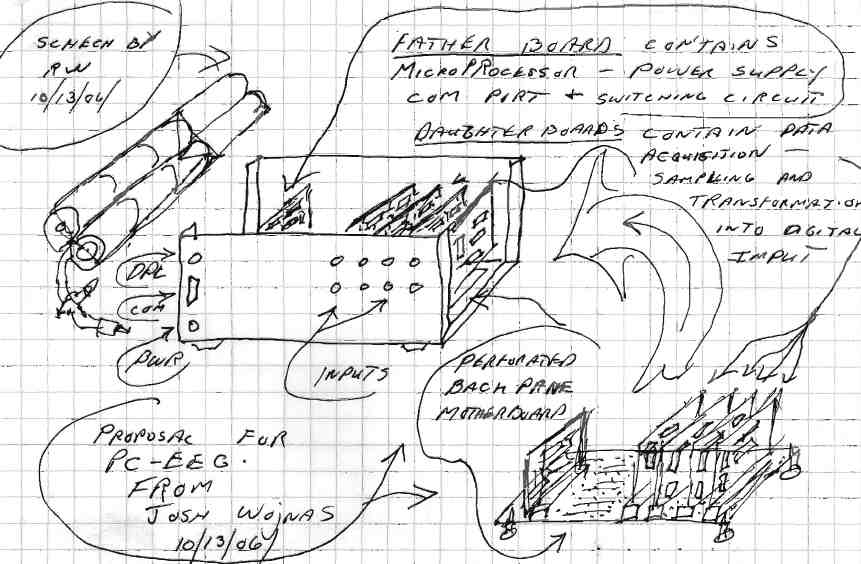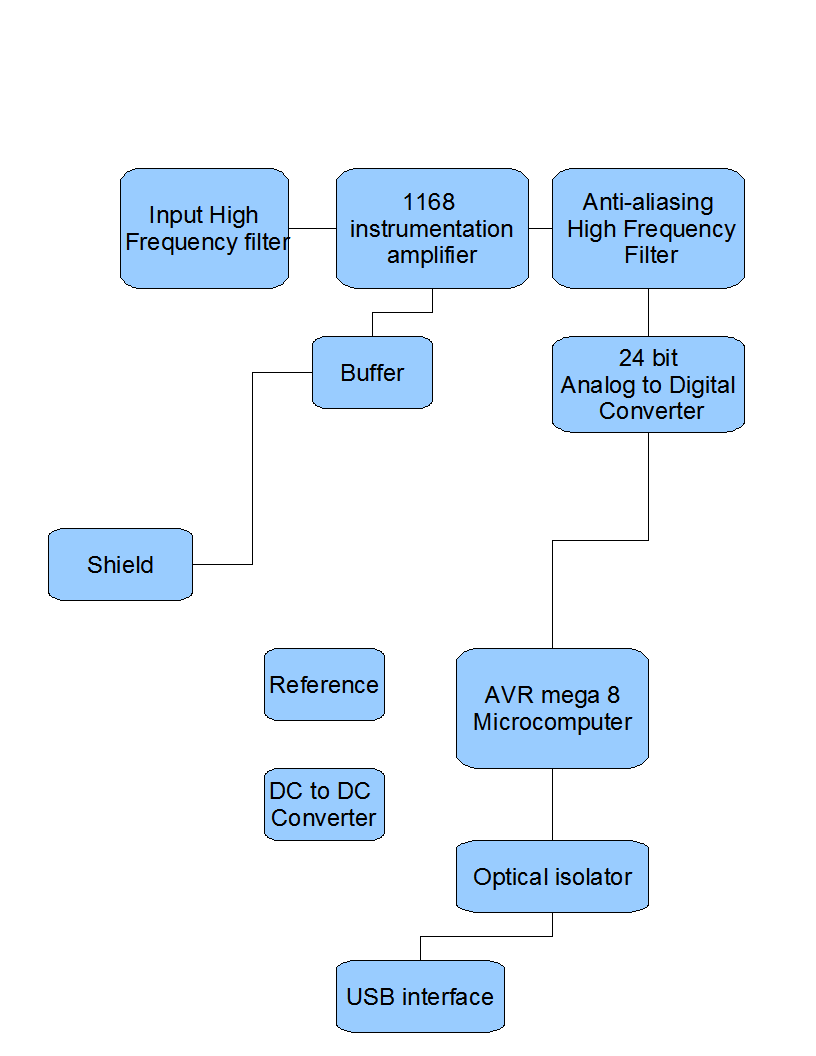Programmable Chip EEG
Contents
- 1 The Programmable Chip EEG
- 2 PCEEG, What it is and why it can be the best
- 3 Status
- 4 Hardware Overview
- 5 ESD Protection in 1168
- 6 Description of How it Works
- 7 Software Tools
- 8 Parts used in the PCEEG:
- 9 News
- 10 Open Source Circuit Design
- 11 Open source (public) results!
- 12 A/D Converters
- 13 ideas for future work
- 14 The Goal
- 15 See also:
The Programmable Chip EEG
Welcome to the PCEEG Wiki, where everyone can add to this EEG brain-computer interface!
PCEEG, What it is and why it can be the best
- The The Programmable Chip EEG gets its name because its hardware and software can be adjusted digitally from a home pc.
- The Programmable Chip EEG is a Modular Multi-channel electroencephalograph.
- This can be used for a brain-computer interface with biofeedback using a flex sensor or servo to detect fingure movements.
- The LT1168 Programmable-Gain Precision Instrumentation Amplifier is used to amplify the weak electric signals coming from the brain through electrodes attached to the scalp, and has internal protection circuitry for the user.
- Several matched LT1114 Low Power Precision OP-Amps are used for amplification and filtering of the signals.
- ESD Protection in LT1168 Programmable-Gain Precision Instrumentation Amplifier Chips have been chosen that fallow the human body model of esd protection this can be seen in the 1168 datasheet.
- To reduce noise in the readout of the analog part of this circuit, a common-mode feedback is passed back into the body by the driver right leg circuit, for example, 60Hz noise from nearby A/C power wiring.
- The analog signal prossesing board will digitize the signal and pass the data to the control board. The control board is based on the AVR Mega168 which will, further process the signals, and provide an interface to a computer.
- we are using the AVR Mega 168 or Mega8.
Status
We currently have a (preliminary?) circuit design and a (prelimary) PCB layout. We are using EAGLE CAD to draw the scematic.
Hardware Overview
Here is a diagram of how the analog signal processing boards and the microprocessor board will come together.
 Here is how the analog signal prossesing board will come together.
Here is how the analog signal prossesing board will come together.

AVR C and the AVR Mega 168 allows for a complete open source system...
ESD Protection in 1168
Chips have been chosen that fallow the human body model of esd protection this can be seen in the 1168 datasheet.
Description of How it Works
The daughter signal prossesing board is responcible for filtering and digitising the signals from the body, then the signals are passed to the control board that is the motherboard. The motherboard then can pass the signal to a larger computer.
The differential analog signal is amplified by the instramentation amplifier. Then the signal is digitised by a analog to digital converter. The a/d converter has aproxamitly 20 bits acuracy so the signal does not have to be conditioned or filtered as much.
The common mode signal is inverted summed and sent back to the body to decrese common mode signal thsi is done by the driver right leg circuit.
Then the analog signals are simultaniously digitized and the digital values can be clocked to the controler motherboard.
The controler board that is the mother board of the system and the signal prossesing daughter boards plug into is the PIC18 useing great cows basic.
How You Can Help
- . get the tools
Software Tools
- EAGLE CAD is being used to create the first PCB. surface mount is used to save space.
- gEDA tools may be a option for opening this design to a wider audience.
- Maxima a computer algebra system s used for graphing and math displays.
- SPI interface code for a/d converters from TI for developers
Parts used in the PCEEG:
- LT1168 Resistor-Programmable-Gain Precision Instrumentation Amplifier is used to amplify the weak electric signals coming from the brain through electrodes attached to the scalp, etc.
- Several LT1114 Low Power Precision OP-Amps are used for amplification and filtering of the signal
To reduce noise in the readout of the analog part of this circuit, a common-mode feedback is passed back into the body by the driver right leg circuit. Band reject filter may also be used (to reject, for example, 60Hz noise from nearby A/C power wiring).
The analog signal prossesing board will digitise the signal and pass the data to the control board. The control board is based on the UBW which will, further process the signals, and provide an interface to a computer & lcd display.
News
The design is switching from LT switcher CAD (aka LTspice SwitcherCAD) to EAGLE CAD, because the auto-router is excellent for open-source productivity. It will allow the design to evolve faster and with less work with a wider selection of PCB Manufacturers.
Here is a picture of the PCEEG being done in EagleCAD.

The ideas and monkey to robot arm interface by Miguel Nicolelisis very inspiring. He used implanted electrodes to monitor and allow monkeys to control a robot arm as if it was their own. Could the PCEEG do the same with its electrodes on the scalp. Only the future will show.
Open Source Circuit Design
- Open Source Circuit Design
- The Programmable Chip EEG Open Source Circuit Design BLog (BrokenLink -- I hope this is only temporarily offline. --DavidCary 10:12, 8 October 2007 (PDT) )
Open source (public) results!
PHP will be used to create a database of users and what they sample and choose to share with the open source community.
The database will give statistical analysis on users recordings.
Also the extension of SETI called BIONIC could be used as a distributed library creation of artifacts and data mining.
Please contribute and make the PCEEG a great tool for researching brain computer interfaces.
A/D Converters
The programmable chip EEG needs an A/D converter to convert the analog signal (at the output of the instrumentation amplifier) into digital bits. We expect this project to require at least 20 bit ADC.
(In 2007-02, some one claimed "We expect this project to require at least 20 bit ADC." -- why? Many people (*) do EKGs with only 10 bit converters.)
- $12.00 The ads1255 by ti is a great a2d converter it has programmable gain and digital low pass filtering with 24 bits of resolution 30KSPS. It is a 20-SSOP so it might be able to be soldered by a hotplate or hot air rework tool.
Many Atmel and other microcontrollers have a built-in ADC, but those are at most 10 bit ADC, so that ADC is useless to us -- we are forced to use an external ADC.
The newest system is a dc amplifier without a high-pass, and all the low-pass filtering is digital
ideas for future work
Currently most EEGs (and EKGs) have "passive electrodes" -- it's a conductive button pressed against the skin, with a long wire that takes the faint signal to the amplifier in the box.
A few EEGs have "active electrodes" -- the amplifier is on top of the conductive button, and sends a strong analog signal down the long wire to the ADC in the box.
User:DavidCary is thinking about going one step further: put the amplifier and the ADC on the electrode, sending out digital packets to the box. Can I do all that with a single chip -- an 8-pin PSoC? Also, instead of each electrode having its own dedicated wire to the data collection box, all the PSoCs are connected in a string (or some other network), forwarding packets from one to the next, so no matter how many electrodes are connected, only about 4 wires (2 power + 2 digital data) are connected. I haven't decided yet whether it's better to have every node do both -- sample data and forward packets -- or if I should split them up, with PSoCs sampling data and sending it to a hub, and hubs (perhaps not PSoCs) forwarding data from a few local PSoCs and from other hubs. --DavidCary 08:50, 10 October 2007 (PDT)
The Goal
Eventually, kits could be sold, if there were interest. More info is available at the PCEEG SourceForge home page at PCEEG sourceforge.net.
See also:
- The OpenEEG wiki
- The Open EEG Brain Computer Interface BLog
- EEG Training Seminars
- wiki cities on pceeg
- pceeg.sourceforge.net
- miguel nicolelis
- Maxima - a computer algebra system
- digital high pass filters and other circuits
- human and computer vision lab
- PCB Manufacturers such as www.batchpcb.com
- eeg biofeedback "mind machine"
- monolith eeg
- yet another pundit disrespects the EEG
- lazer cutting for box & solder paste stencil
- Build Your Own Printed Circuit Board
- solder paste for surface mount that can be stored at room temperature
- The thread "amplifying biomedical signals: 150 uA with 16 bit resolution?" has several op-amp suggestions, and mentions that "a good, low-noise, low-cost, isolated EMG/EEG amplifier is one of the most demanding analog electronics designs."
- How to build your own ECG device
- neurofeedback helps musicians improve their musical performances by 13 to 17 per cent.
- "the World's largest Biofeedback and Neurofeedback Discussion Group"
- TI app note "Biophysical Monitoring: Electrocardiogram (ECG) Front End" has a simple circuit: 390 KOhm resistors in-line with each lead -- one end touches patient, the other end directly connected to the instrumentation amp input (or the right-leg drive amplifier output, which has no further protection). The inst. amp has 2 protection diodes on each input, directly to +power and -power. Also, 39 pF capacitor from each input to analog GND, and 200 pF between the 2 inputs. The TI publication "Information for Medical Applications" (2Q 2004) reprints that circuit, but leaves out the caps and the diodes.
- (*) Some people use 420 Hz sampling rate, 10 bits/sample.
- "High-Resolution QRS Detection Algorithm for Sparsely Sampled ECG Recordings" by Timo Bragge et. al. 2004 recommends: "the sampling frequency of the ECG should be at least 500 Hz"
- "Low-Power, Low-Voltage IC Choices for ECG System Requirements" by Jon Firth and Paul Errico says "The multiplexed architecture, based on an old assumption that the converter is by far the most-expensive front-end component, is prevalent in today's electrophysiological measurement systems. However, with the proliferation of sigma-delta converter architectures, converter-per-channel is now a power- and cost-competitive alternative". It also gives a typical schematic for both architectures and suggests some parts.
- Is there a Medical Electronics Forum?
- Make: Homemade Electrocardiograph ([1] recommends skin lotion or shampoo as a low-cost electrode gel)